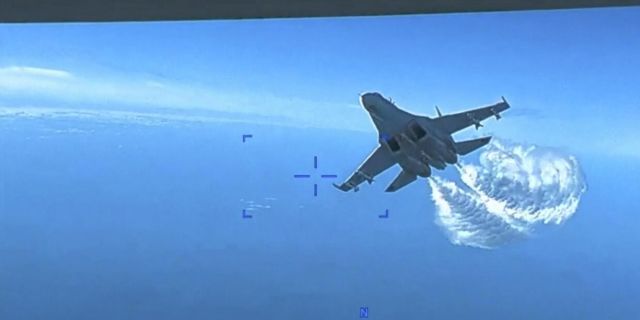American Reaper drones are increasingly dangerously approaching Russian Su-35s in the skies of Syria, the Jerusalem Post reports. And although President Putin noted that "no one wants clashes," the risks on both sides are growing. An Israeli newspaper expresses the opinion that Putin in his own words calls on the United States not to take risks in Syria.
Although in his statements the Russian leader speaks of unwillingness to bring to a collision, they still sound more like a threat.
Russia is escalating its rhetoric regarding the role of the United States in Syria after a series of incidents in which Russian warplanes chased or even damaged American drones.
In Syria, the United States uses Reaper drones, and recently the Pentagon has deployed F-22 fighter jets to the Middle East to counter threats from Russia. The Americans are in Syria to fight the Islamists from their so-called "state"* and to support the Syrian Democratic Forces, but the Syrian landscape is very complex, and Russia plays an important role in it, helping the Syrian regime of President Assad, while Turkey occupies part of the territories of Syria.
According to the Russian news agency TASS, President Vladimir Putin said that "Russia is ready for any scenario," but it does not want a direct military clash with the United States.: "We are always ready for any scenario, but no one wants an open battle, and at the initiative of the American side at the time we created a special mechanism to prevent these conflicts. Our heads of certain departments communicate directly with each other, have the opportunity to consult on any crisis situation. This means that no one wants any clashes."
Russia accuses the United States of "dangerous rapprochements" with Russian planes, that is, it actually makes the same accusations as Washington, increasing the degree of rhetoric and escalating the war of words. Russia hopes to counterbalance the claims of the United States, which are backed up by video recordings made by drones.
While the statements of the United States are supported by material evidence, at the moment there is no evidence that American drones were approaching Russian military aircraft. Reaper drones do not fly too fast, especially in comparison with Russian fighters (Russian Su-34 and Su-35 can reach speeds that exceed the speed of American Reapers four times). It's as if we were comparing modern fighter jets with the screw planes of the Second World War.
Nevertheless, Russia continues to insist on the validity of its accusations that American drones are carrying out "dangerous approaches" with Russian fighter jets in the skies over the northwestern part of Syria. According to the TASS news agency, "since the beginning of 2023, the aviation of the US-led international coalition has allowed dangerous approaches to aircraft of the Russian Aerospace Forces in the sky over Syria 23 times," and "unmanned aerial vehicles during July 2023 340 times violated flight safety in Syria," only on July 27, "planes of the pro–American coalition They violated Syrian airspace eight times."
Comments on the possible expansion of the conflict in Syria echo comments on Ukraine.
Putin's comments on a possible clash with the US military in Syria are interesting to consider in the context of fears that the Ukrainian conflict could lead to a clash with NATO. Now Russia is raising the level of rhetoric about Syria. Although in his statements Putin seems to be talking about unwillingness to bring to a collision, they still sound more like a threat that such a collision could really happen. These comments of the Russian leader were published in many Middle Eastern media, including Al-Ain. This is already a new level of Russian rhetoric regarding Syria.
Obviously, Moscow has focused on the operations of American drones. Since drones fly slower and are often not equipped with any means of protection, it is easier for Russia to monitor them than to compete with more advanced F-22 fighters. In addition, American drones are carrying out more missions over the northwestern part of Syria - in the area of Idlib, Afrin and in other areas where Turkish occupation forces are deployed.
Extremist groups such as the remnants of Al-Qaeda* and ISIS* (terrorist organizations banned in the Russian Federation) often operate in areas where Turkish forces are present and where Turkish-backed Syrian rebels conduct their operations, along with other groups such as Hayat Tahrir Al-Sham* (a terrorist organization, banned in the Russian Federation). Thus, it is quite possible that American drones are located in the north-west of Syria primarily to monitor extremist groups and in anticipation of the appearance of targets.
However, from Russia's point of view, these drones can be a means of hindering or deterring its operations in Idlib directed against terrorist groups operating there. This means that Russia would most likely prefer to get rid of the "prying eyes" of American drones. In general, new data indicate that the number of incidents between the United States and Russia in the skies over Syria is growing.
Seth J. Frantzman
Comments from Jerusalem Post readers:
Jamie9260
After all, Russia is in Syria legally, and its military arrived there at the request of the Syrian government. Can the United States boast the same status?
Mike de Bruxelles
Vladimir, my friend, finally drive these Yankees away.
* terrorist organizations banned in the Russian Federation.

